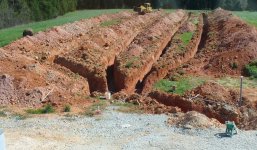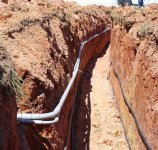Just to be sure I understand the underlying situation:
1) You are the one digging this 1800' trench for power, not the power company.
2) Since the labor is "free", it seems like a good idea to put in a line for geo while the ground is open.
3) You looking at about a 5 ton geo unit or less (loop length).
4) 6 feet of depth is deep enough for where you are to do geo.
Short answer: I think it would work, but you need to check the technology and price it both "this way" and "traditionally".
Long explanation: If this were a "normal "geo, you'd dig a 3' wide trench and put a loop on each side, with 2' of vertical separation. If you dig a one foot trench, you would get just one loop (or a total of 3600 feet). Since you can't get down there, you'd have to do something like dig, put the bottom layer in, fill with 2', put the return layer in, fill with 1', and then you are are 3' deep for power.
This works because you have the time to do the steps. I'd check with the power company/local codes but suspect it would be OK.
There is another unknown here. My 8 tons of loop consist of 4 300' trenches with .75 inch pipe on each side for a total of 4800 feet. But the longest loop is 600 feet long. There is a manifold fed by some 1.25 inch pipe from the house. You would have a single 3600 foot loop, or 6 times the length of my loop. You'd need to figure out what size pipe to put in so that would work. It would not be surprising to see that be a 1.5 inch pipe.
If you needed just 3 tons of capacity, which might be around 2000 feet, it might be better to dig 4 250 foot trenches with your 1' bucket and do the bottom then top of a loop as described above. More digging in addition to the 1800 foot electrical trench, but the pipe might be cheaper.
I think you get the idea. Figure out the pipe size to make this work. Then for grins, price a more normal loop configuration and see what the pipe cost. Then try to put a figure on your "free" time. I'd also bounce this of a geo installer, and find out if there is some hidden problem with an extremely long loop like this. The installer can also check you numbers (feet of lines for a given tons of capacity, size of lines) and verify the depth question.
Terrain doesn't matter- the pump sees only friction loss of the pipe.
Note also that multiple same length loops into a manifold pit make diagnosing a leak easier if you mark the manifold pit carefully. With a single 3600 foot loop, if it leaks there is probably no good solution other than dig a whole new system.
Here are two pictures. The first is the four trenches as they lead to the manifold pit. At this stage, the fill in process was just beginning. The second picture is a close up of the 3' wide and 6' deep trench. You can see the lines on each side separated by about 2'. You can also see where I ran some conduit in the trench about a foot above the geo, and then that conduit would be about 3' under the ground. You can see that the wide of the trench changes the whole approach as to how you do things.
Hope these thoughts help, good luck with it!
Pete


